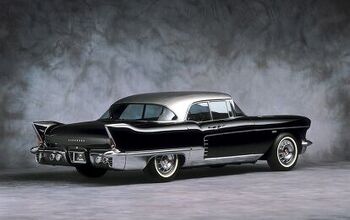2018 Mitsubishi Outlander PHEV Review - The Waiting Was the Hardest Part

2018 Mitsubishi Outlander PHEV
The idea was as obvious as it was brilliant. Take the hottest segment of motor vehicles on the market and stick an improbably high fuel economy figure on the window sticker. The hybrid revolution made the ungainly Prius a certified success — so why not a crossover? And why not add a plug to it, letting it run on battery power for a longer distance?
In 2013, Mitsubishi did just that, only overseas. Americans would have to wait.
Finally, the 2018 model year brought the Mitsubishi Outlander PHEV to stateside showrooms. Boasting around 22 miles of all-electric driving range, this plug-in hybrid crossover could meet many drivers’ commuting needs without using a drop of fuel. Was it worth the wait?
Driving the Outlander PHEV is quite similar to the non-hybrid version I reviewed a few months ago, with some exceptions. The biggest difference? While this plug-in hybrid likely has less overall horsepower than the V6 Outlander I drove then, the instantaneous torque from the pair of electric motors feels stronger in everyday driving. Further, when the Outlander PHEV is able to operate in electric-only mode, one quickly notices how much noise is generated by the gasoline engine. Light road and wind noise is still present, but the electric drivetrain makes a big difference.
Adaptive cruise control is a wonderful feature, but unlike most, this system beeps as cars come into and out of the “view” of the system. It’s quite annoying until you learn to tune out the beep. It’s as if the car loses and reacquires missile lock, Top Gun-style, as the MiG-28 flying overhead (Prius in the left lane ahead) speeds up or slows down.
I’m still not a fan of the styling, though in this darker shade it’s less jarring than in the silver I looked at before. Interestingly, Mitsubishi calls this color Ruby Black Pearl — in the right light, there is an incredibly deep burgundy color to it. Unfortunately, both the fading sunlight and my lack of photography talent conspired to make it appear glossy black on these digital pages. Trust me — it’s pretty in person.
I don’t approve of the look-at-me-I’m-saving-the-whales “PHEV” stickers plastered on the flanks. I suppose some who buy a plug-in hybrid do so to signal their virtue, but for me it’s too much.
The interior works well enough, though my past complaints about material quality remain. The way the front seats will rock fore and aft under acceleration or braking is still disconcerting, though that I’ve now noticed such behavior in at least three variants of the Outlander/Outlander Sport line tells me it seems to be a feature Mitsubishi was going for.
One note: the paddles mounted on the steering wheel aren’t for gear selection. Recall the Outlander PHEV doesn’t have a traditional transmission. Rather, the paddles allow the driver to toggle between varying levels of regenerative braking. Should you find yourself coasting down a long grade, clicking the paddle a couple of times to invoke stronger “engine” braking will add charge back into the battery, while saving the friction brakes a bit of work.
I did learn something interesting during my week with the Outlander PHEV — my house isn’t quite ready for plug-in hybrid vehicles. Seems my microwave, mounted over my oven, is wired into the same circuit that powers much of my garage. Including the outlet where I plugged in the Outlander PHEV. I’d never noticed this before, as my habit was to plug in any cars late in the evening, shortly before bed. Not this time — I plugged in the Mitsubishi, then proceeded to make popcorn.
Seems the amp draw between the microwave and the car is a bit too much for the forty-year-old wiring in this suburban tract house. It took a few tries — and stumbling down the stairs, using my cellphone as a flashlight, to reset the breaker — before I realized my mistake.
Mercifully, should one have access to a Level 3 DC CHAdeMO fast-charging station, the Outlander PHEV can charge to eighty percent of capacity in about 25 minutes, according to Mitsubishi.
[Get new and used Mitsubishi Outlander PHEV pricing here!]
Mitsubishi has turned an acceptable crossover into a pretty good plug-in hybrid crossover with the Outlander PHEV. Shame it couldn’t have made it to our shores in 2014. Or 2016. Or 2017. It remains popular overseas, where it was one of the first plug-in hybrids to reach the market. Now that Mitsubishi has ceded the race to be first, there are too many more compelling options.
[Images: © 2019 Chris Tonn/TTAC]

Some enthusiasts say they were born with gasoline in their veins. Chris Tonn, on the other hand, had rust flakes in his eyes nearly since birth. Living in salty Ohio and being hopelessly addicted to vintage British and Japanese steel will do that to you. His work has appeared in eBay Motors, Hagerty, The Truth About Cars, Reader's Digest, AutoGuide, Family Handyman, and Jalopnik. He is a member of the Midwest Automotive Media Association, and he's currently looking for the safety glasses he just set down somewhere.
More by Chris Tonn
Latest Car Reviews
Read moreLatest Product Reviews
Read moreRecent Comments
- Calrson Fan Jeff - Agree with what you said. I think currently an EV pick-up could work in a commercial/fleet application. As someone on this site stated, w/current tech. battery vehicles just do not scale well. EBFlex - No one wanted to hate the Cyber Truck more than me but I can't ignore all the new technology and innovative thinking that went into it. There is a lot I like about it. GM, Ford & Ram should incorporate some it's design cues into their ICE trucks.
- Michael S6 Very confusing if the move is permanent or temporary.
- Jrhurren Worked in Detroit 18 years, live 20 minutes away. Ren Cen is a gem, but a very terrible design inside. I’m surprised GM stuck it out as long as they did there.
- Carson D I thought that this was going to be a comparison of BFGoodrich's different truck tires.
- Tassos Jong-iL North Korea is saving pokemon cards and amibos to buy GM in 10 years, we hope.
















































Comments
Join the conversation
The PHEV stickers have to go. Such labels were an option on the Gen 1 Leaf, and thankfully mine didn't have them. The Chademo charging standard is used only by Nissan and Mitsubishi at this point, and - in the interest of streamlining charging standards in the US - it needs to go away. CCS and Tesla are the strongest, and really ought to converge into just one standard, IMO. Another annoying thing EV makers do: describing their motor power in kW. Using Horsepower is perfectly fine, and would help sell vehicles.
On EV house wiring... A microwave should have its own circuit, since they easily draw 10-15 amps all by themselves. This is good practice even without having an EV. Space heaters and hair dryers use similar power. An EV 110V charger will draw around 12 amps, so it should only be used on an otherwise quiet circuit. An EV 240V charger will draw around 30+ amps, so it needs to be treated like an electric range, with its own circuit. I have a 50+ year old house with 150-amp service. The microwave is on its own circuit, as is the electric range and the EV charger. I've never tripped a breaker for these things.